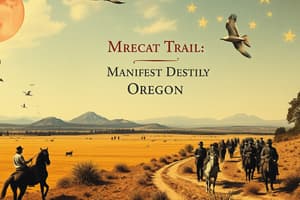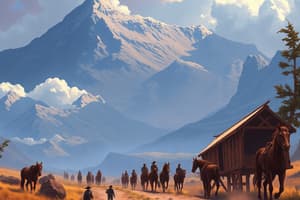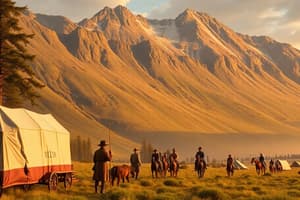Podcast
Questions and Answers
How did the Dawes Act of 1887 aim to change Native American social structures?
How did the Dawes Act of 1887 aim to change Native American social structures?
- By granting Native American tribes greater autonomy over their territories.
- By encouraging Native Americans to maintain their traditional nomadic lifestyles.
- By reinforcing tribal unity through collective land ownership.
- By dividing communal lands into individual plots, undermining tribal structures. (correct)
Which statement best describes the relationship between Manifest Destiny and western expansion?
Which statement best describes the relationship between Manifest Destiny and western expansion?
- Manifest Destiny primarily focused on maintaining peaceful relations with Native American tribes.
- Manifest Destiny provided a moral and ideological justification for territorial expansion. (correct)
- Western expansion occurred independently of any guiding philosophies like Manifest Destiny.
- Manifest Destiny was a direct result of the economic policies enacted during western expansion.
Which of the following best characterizes settler colonialism?
Which of the following best characterizes settler colonialism?
- A structure aiming to replace Indigenous populations with a new settler society. (correct)
- A form of colonialism focused solely on resource extraction without displacing the original inhabitants.
- A temporary occupation of land with the intent of returning it to the Indigenous population after resource extraction.
- A system in which colonizers and Indigenous populations coexist peacefully with mutual respect.
How did the social construction of race influence the treatment of different groups in the American West?
How did the social construction of race influence the treatment of different groups in the American West?
What was the primary goal of the Chinese Exclusion Act of 1882?
What was the primary goal of the Chinese Exclusion Act of 1882?
How did the 13th, 14th, and 15th Amendments impact African Americans in the West during Reconstruction?
How did the 13th, 14th, and 15th Amendments impact African Americans in the West during Reconstruction?
Which of these options describes a key theme in City of Inmates regarding racial control in Los Angeles?
Which of these options describes a key theme in City of Inmates regarding racial control in Los Angeles?
During the period of Western expansion, what was the primary purpose of 'Alien Land Laws'?
During the period of Western expansion, what was the primary purpose of 'Alien Land Laws'?
How did the changing governance in California influence racial identity, as exemplified by Pio Pico?
How did the changing governance in California influence racial identity, as exemplified by Pio Pico?
What was a primary method of resistance employed by the Comanche tribe against European colonizers?
What was a primary method of resistance employed by the Comanche tribe against European colonizers?
What was the significance of Biddy Mason's legal challenge in California?
What was the significance of Biddy Mason's legal challenge in California?
How did the Industrial Workers of the World (IWW) differ from the American Federation of Labor (AFL) in their approach to labor organization?
How did the Industrial Workers of the World (IWW) differ from the American Federation of Labor (AFL) in their approach to labor organization?
What does the limerick about the Frontier Theory suggest about traditional narratives of westward expansion?
What does the limerick about the Frontier Theory suggest about traditional narratives of westward expansion?
What was the primary objective of the San Gabriel Mission in relation to the Native American populations?
What was the primary objective of the San Gabriel Mission in relation to the Native American populations?
What was the impact of railroad expansion on labor in the American West?
What was the impact of railroad expansion on labor in the American West?
How does the text characterize the 'mining boomtowns' that emerged in the American West?
How does the text characterize the 'mining boomtowns' that emerged in the American West?
What was the practical effect of the Sharecropping System that emerged in the American South after the Civil War?
What was the practical effect of the Sharecropping System that emerged in the American South after the Civil War?
What does the example of Jesse Washington's lynching reveal about media coverage and authority response during that time?
What does the example of Jesse Washington's lynching reveal about media coverage and authority response during that time?
Which of the following best describes the impact of the Indian Removal Act?
Which of the following best describes the impact of the Indian Removal Act?
What was the significance of the Chinese Exclusion Act of 1882 and subsequent legislation like the Geary Act?
What was the significance of the Chinese Exclusion Act of 1882 and subsequent legislation like the Geary Act?
What does the concept of 'incarceration as racial control' refer to in the context of the American West?
What does the concept of 'incarceration as racial control' refer to in the context of the American West?
What was the 'Anti-Testimony Law' and what impact did it have on Chinese immigrants in the American West?
What was the 'Anti-Testimony Law' and what impact did it have on Chinese immigrants in the American West?
What was a common characteristic of the various acts of violence and resistance that took place in the American West?
What was a common characteristic of the various acts of violence and resistance that took place in the American West?
Flashcards
Manifest Destiny
Manifest Destiny
The belief that Americans had a divine right to expand westward across the continent.
Homestead Act (1862)
Homestead Act (1862)
An act that gave settlers 160 acres of land to encourage migration to the West.
Dawes Act (1887)
Dawes Act (1887)
Divided Native American lands into individual plots, undermining tribal unity and traditional ways of life.
Social Construction of Race
Social Construction of Race
Signup and view all the flashcards
Chinese Exclusion Act (1882)
Chinese Exclusion Act (1882)
Signup and view all the flashcards
Alien Land Laws
Alien Land Laws
Signup and view all the flashcards
Foreign Miners' Tax
Foreign Miners' Tax
Signup and view all the flashcards
Black Codes
Black Codes
Signup and view all the flashcards
Railroad Expansion
Railroad Expansion
Signup and view all the flashcards
Mining Boomtowns
Mining Boomtowns
Signup and view all the flashcards
Mexican-American Dispossession
Mexican-American Dispossession
Signup and view all the flashcards
Sharecropping System
Sharecropping System
Signup and view all the flashcards
Incarceration as Racial Control
Incarceration as Racial Control
Signup and view all the flashcards
Biddy Mason
Biddy Mason
Signup and view all the flashcards
Pio Pico
Pio Pico
Signup and view all the flashcards
Tongva Gabrielinos
Tongva Gabrielinos
Signup and view all the flashcards
Lynching and Jesse Washington
Lynching and Jesse Washington
Signup and view all the flashcards
San Gabriel Mission
San Gabriel Mission
Signup and view all the flashcards
Comanche
Comanche
Signup and view all the flashcards
Indian Removal Act
Indian Removal Act
Signup and view all the flashcards
1882 Chinese Exclusion Act
1882 Chinese Exclusion Act
Signup and view all the flashcards
IWW (Industrial Workers of the World)
IWW (Industrial Workers of the World)
Signup and view all the flashcards
Critique of Frontier Theory
Critique of Frontier Theory
Signup and view all the flashcards
Study Notes
- Frontier & Expansion
- Frontier Thesis: Frederick Jackson Turner's concept that the frontier shaped American democracy and individualism.
- Manifest Destiny: The belief that Americans had a divine right to expand westward.
- Homestead Act (1862): Granted settlers 160 acres of land to encourage western migration.
- Dawes Act (1887): Divided Native lands into individual plots, undermining tribal unity.
- Indian Removal Act (1830): Forced relocation of Native American tribes, leading to the Trail of Tears.
- Western Conquest: Systematic military, economic, and political efforts to seize Native land and resources.
- Settler Colonialism: Settlers aim to replace Indigenous populations rather than coexist.
- Genocide (UN Definition): Intent to destroy a group through killing, forced removal, or cultural erasure.
- Plains Wars: Conflicts between Native American tribes and U.S. expansionists. Examples include the Red River War and the Battle of Little Bighorn.
Race, Labor & Violence in the West
- Social Construction of Race: Race is not biologically real but is used for political and social control.
- Racial Violence in the West: Mass lynchings, exclusion laws, and violent attacks on marginalized groups occurred.
- Chinese Exclusion Act (1882): The first law to restrict immigration based on race/nationality.
- Anti-Chinese Massacre (1871): 17-22 Chinese men were killed in Los Angeles.
- Rock Springs Massacre (1885): White miners killed Chinese laborers in Wyoming.
- Alien Land Laws: Restricted land ownership by Asian immigrants in the West.
- Foreign Miners' Tax: aimed at Chinese and Mexican miners in California.
- Mexican Resistance to Mob Violence: Mexican communities resisted lynching and racial violence.
Reconstruction & Racial Politics
- 13th Amendment: Abolished slavery.
- 14th Amendment: Granted citizenship.
- 15th Amendment: Protected voting rights.
- Jim Crow in the West: Racial segregation and legal discrimination occurred in California and other western states.
- Black Codes: Restricted Black people’s freedoms after the Civil War, often forcing them into labor contracts.
- Lynching and Racial Terror: A tool of white supremacy used against African and Mexican Americans.
- Freedom Claims in the West: African American efforts were aimed at claiming rights and resisting segregation in California.
- City of Inmates (Hernandez): There is a connection between racial control and mass incarceration in Los Angeles.
Economic & Political Forces in the West
- Railroad Expansion: Transcontinental railroads facilitated migration while exploiting labor.
- Mining Boomtowns: Temporary settlements formed around mining rushes, often leading to environmental destruction.
- Mexican American Dispossession: Land loss and economic exploitation of Mexican communities occurred in the Southwest.
- Violence & Resistance in the West: Marginalized communities pushed back against racial violence.
- Sharecropping System: A labor system replaced slavery but kept Black farmers in debt.
- The Fight for the Frontier (Limerick): Conquest, not democracy, shaped the West.
- Incarceration as Racial Control: Imprisonment was used to police and remove marginalized groups from society.
Key People & Groups
- Biddy Mason:
- She was forced to work for her slave owner in California despite it being a "free soil" state.
- Challenged slavery in court in California.
- She made an effort to bring the lack of freedom into state’s political atmosphere
- She founded the 1st African Methodist church in LA.
- A judge ruled against Smith and granted her freedom to work independently.
- Mason became one of wealthiest African Americans.
- Displays the early political action from those often overlooked in abolitionist efforts.
- Pio Pico:
- Race is not biological but shaped by social construct.
- Born into a Spanish-speaking family in California with a mixed background.
- His racial identity was viewed differently based on who was in power.
- Tongva Gabrielinos:
- Native American indigenous to the Los Angeles Basin and the Southern Channel Islands in California.
- They resisted against San Gabriel Mission.
- Perkins Family:
- Jesse Washington:
- Brutally lynched after being accused of killing Lucy.
- Media did NOT show coverage about this event
- Authorities in Waco made efforts to ‘bury’ this occurrence.
- White people displayed pride at the scene.
- Shops and schools closed for people to watch.
- San Gabriel Mission:
- A Spanish mission to colonize and indoctrinate Native Americans.
- It forced the spread of Christianity and eradicated Native traditions.
- The mission relied on seizing control over indigenous populations in their moral, economic, and physical freedoms.
- Comanche:
- A Native American population that resisted European conquerors.
- Seized horses and became successful breeders.
- This provided mobility and helped form tribal identity.
- Maintained traditions and culture despite European presence.
- Their survival is defiance.
- Indian Removal Act:
- All Native Americans west of the Mississippi needed to be relocated and stripped of their land.
- Toyperina:
- “Boxcar people”.
- Mother Jones:
- CF&I:
- IWW:
- Diverse recruitment, including people of color and women.
- Aided social equality.
- Addressed women's issues, i.e. birth control and suffrage.
- AFL:
- Shaped the U.S. labor movement and advocated for worker rights.
- Focused on skilled labor unions.
Laws/Acts
- 1882 Chinese Exclusion Act
- The Geary Act
- Anti-Testimony Law
- 1852 Fugitive Slave Act
Events
- Lynching of Jesse Washington
- Boarding Schools
- Chinese Massacre
- Ludlow Massacre
Limerick's Critique of Frontier Theory
- Biased narrative favoring "only one of the contesting groups".
- East to west narrative erases/oversimplifies preexistence of diverse populations.
- The theory makes it Impossible to define the frontier's beginning and end.
- The traditional narrative retells westward expansion with “innocence and exceptionalism”.
- Relied too heavily on Frederick Jackson Turner's definition of the frontier.
- Turner believed the frontier encouraged individualism and innovation.
- There's a narrative that the West was open for taking due to a perceived lack of development, justifying colonization.
Studying That Suits You
Use AI to generate personalized quizzes and flashcards to suit your learning preferences.




